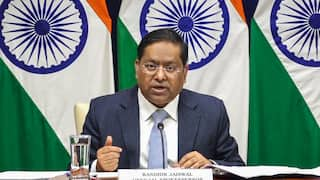PSLV C-52: ISRO Successfully Launches Earth Observation Satellite, 2 Co-Passenger Satellites Today
PSLV lifted off at 5:59 am IST from the First Launch Pad at SHAR, as part of the PSLV C5-2/EOS-04 mission.

New Delhi: The Indian Space Research Organisation (ISRO) successfully launched its first mission of the year on Monday, February 14.
India's Polar Satellite Launch Vehicle PSLV-C52 injected Earth Observation Satellite EOS-04, into an intended sun synchronous polar orbit of 529 kilometres, on Monday, at 6:17 am IST, from Satish Dhawan Space Centre, SHAR (Sriharikota Range), Sriharikota, Andhra Pradesh, the Indian space agency said in a statement.
India’s Polar Satellite Launch Vehicle PSLV-C52 injected Earth Observation Satellite EOS-04, into an intended sun synchronous polar orbit of 529 km altitude at 06:17 hours IST on February 14, 2022 from Satish Dhawan Space Centre, SHAR, Sriharikota. https://t.co/BisacQP8Qf
— ISRO (@isro) February 14, 2022
PSLV lifted off at 5:59 am IST from the First Launch Pad at SHAR, as part of the PSLV C5-2/EOS-04 mission.
Union Minister for Road Transport and Highways, Nitin Gadkari, congratulated the team of ISRO on the successful launch of the radar imaging satellite and the two co-passenger satellites.
All About The PSLV C5-2 Mission
This was the 80th launch vehicle mission from SDSC SHAR, Sriharikota, and the 54th flight of PSLV. This was also the 23rd mission using PSLV-XL configuration with six solid propellent strap-on motors (PSOM-XL).
PSLV-C52 will carry two small satellites as co-passengers, according to ISRO.
The two satellites to be carried as co-passengers include one student satellite, called INSPIREsat-1 from Indian institute of Space Science and Technology (IIST) in association with Laboratory of Atmospheric and Space Physics at University of Colorado, Boulder, and a technology demonstrator satellite (INS-2TD) from the Indian space agency. INS-2TD is a precursor to India-Bhutan Joint Satellite (INS-2B).
What Is EOS-04?
EOS-04 is a radar imaging satellite designed to provide high quality images under all weather conditions for several applications such as Agriculture, Forestry and Plantations, Soil Moisture and Hydrology, and Flood Mapping, according to ISRO.
The two scientific payloads are designed to improve the understanding of ionosphere dynamics and the Sun's coronal heating processes, according to ISRO.
EOS-04 will collect Earth observation data in C-band, and complement/supplement the data from Resourcesat, Cartosat series, and RISAT-2B series.
INS-2TD, a technology demonstrator satellite from ISRO, has a thermal imaging camera as its payload. The satellite helps in the assessment of land surface temperature, water surface temperature of wetlands and lakes, delineation of vegetation, including crops and forests, and thermal inertia, during the day as well as night.
INS-2TD and INSPIREsat-1 have masses of 17.5 kilograms and 8.1 kilograms respectively.
The mission of INS-2TD will last six months, while that of INSPIREsat-1 will last a year.
The EOS-04 satellite generates 2280 Watt power and has a mission life of 10 years.
The co-passenger satellites were successfully separated from the PSLV in a predetermined sequence, ISRO said on its website.
Shri S Somanath, Chairman of the Indian space agency, congratulated team ISRO for the precision with which the mission was accomplished.






































